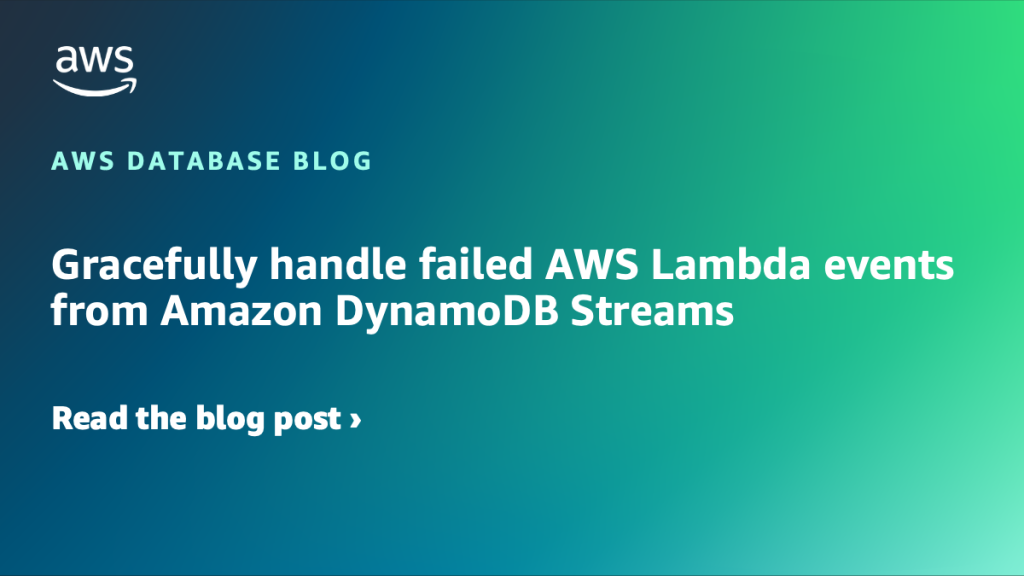AWS Database Blog
Category: Amazon Simple Storage Service (S3)
Gracefully handle failed AWS Lambda events from Amazon DynamoDB Streams
In this post, we show how to capture and retain failed stream events for later analysis or replay using Amazon S3 as a durable destination. We compare this approach with the traditional Amazon SQS dead-letter queue (DLQ) pattern, and explain when and why Amazon S3 is a preferred option.
Modernize your legacy databases with AWS data lakes, Part 1: Migrate SQL Server using AWS DMS
This is a three-part series in which we discuss the end-to-end process of building a data lake from a legacy SQL Server database. In this post, we show you how to build data pipelines to replicate data from Microsoft SQL Server to a data lake in Amazon S3 using AWS DMS. You can extend the solution presented in this post to other database engines like PostgreSQL, MySQL, and Oracle.
Configure cross-account Amazon S3 as a source or target for AWS DMS
In this post, we delve into the intricacies of configuring AWS DMS replication instances to use an S3 bucket in a different account. We also explore the process of establishing a connection between AWS DMS Serverless and S3 buckets across distinct accounts.
Migrate Amazon RDS for Oracle BLOB column data to Amazon S3
In this post, we demonstrate an architecture pattern in which we migrate BLOB column data from Amazon RDS for Oracle tables to Amazon S3. This solution allows you to choose the specific columns and rows containing BLOB data that you want to migrate to Amazon S3. It uses Amazon S3 integration, which enables you to copy data between an RDS for Oracle instance and Amazon S3 using SQL.
Turn petabytes of relational database records into a cost-efficient audit trail using Amazon Athena, AWS DMS, Amazon RDS, and Amazon S3
In this post, we show how you can use AWS Database Migration Service (AWS DMS) to migrate relational data from Amazon RDS into compressed archives on Amazon S3. We discuss partitioning strategies for the resulting archive objects and how to use S3 Object Lock to protect the archive objects from modification. Lastly, we demonstrate how to query the archive objects using SQL syntax through Athena with seconds latency, even on large datasets.
Use AWS DMS to migrate data from IBM Db2 DPF to an AWS target
AWS has introduced a new feature in AWS Database Migration Service (AWS DMS) that simplifies the migration of data from IBM Db2 databases with the Database Partitioning Feature (DPF) databases to Amazon Simple Storage Service (Amazon S3), a highly scalable and durable object storage service. With this new capability, you can now migrate your data from IBM Db2 DPF databases to Amazon S3, paving the way for building robust data lakes in the cloud. This new feature streamlines the migration process, provides data integrity, and minimizes the risk of data loss or corruption, even when dealing with large volumes of data distributed across multiple partitions and databases of varying sizes. In this post, we delve into the intricacies of this new AWS DMS feature and demonstrate how to implement it. We explore best practices for orchestrating data flows and optimizing the migration process, achieving a smooth transition from on-premises IBM Db2 DPF databases to a cloud-based data lake on Amazon S3.
Troubleshoot and minimize AWS DMS replication latency with Amazon S3 as a target
Building data sources on Amazon Simple Storage Service (Amazon S3) can provide substantial benefits for analysis pipelines because it allows you to access multiple large data sources, optimize the curation of new ingestion pipelines, build artificial intelligence (AI) and machine learning (ML) models, providing customised experiences for customers and consumers alike. In this post, we […]
Run Polygon nodes on AWS
In this post, we dive deep into establishing your infrastructure and deploying Polygon blockchain nodes on AWS. We provide recommendations for selecting optimal compute and storage options tailored to various use cases. We discuss the approach to speed up the horizontal scaling of Polygon full nodes on AWS with Amazon Simple Storage Service (Amazon S3) […]
Introducing the Amazon Timestream UNLOAD statement: Export time-series data for additional insights
Amazon Timestream is a fully managed, scalable, and serverless time series database service that makes it easy to store and analyze trillions of events per day. Customers across a broad range of industry verticals have adopted Timestream to derive real-time insights, monitor critical business applications, and analyze millions of real-time events across websites and applications. […]
Cross-account Amazon RDS for Oracle migration using Amazon RDS snapshots and AWS DMS for minimal downtime
In scenarios such as consolidating or merging multiple departments with separate AWS accounts into a single AWS account, splitting a single account or divisions into multiple AWS accounts for better management, or duplicating an AWS account across Regions, you often need to migrate the database from one AWS account to another with minimal downtime and […]









